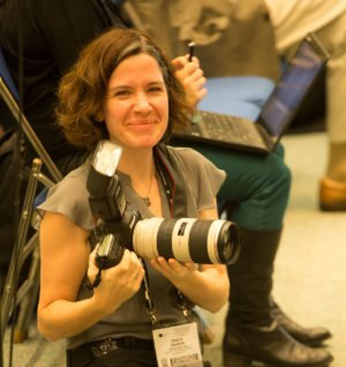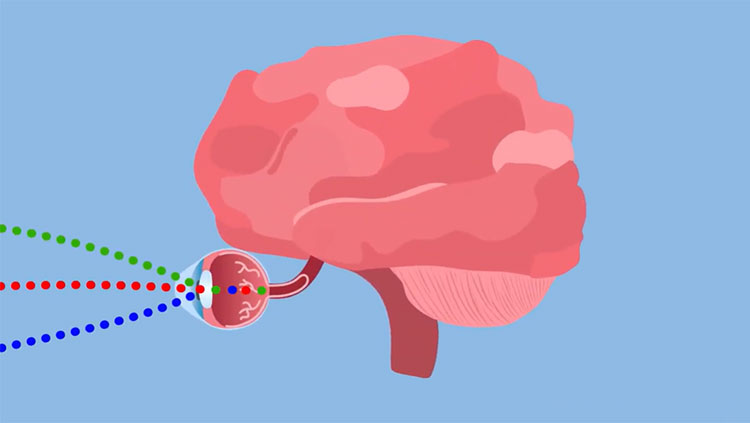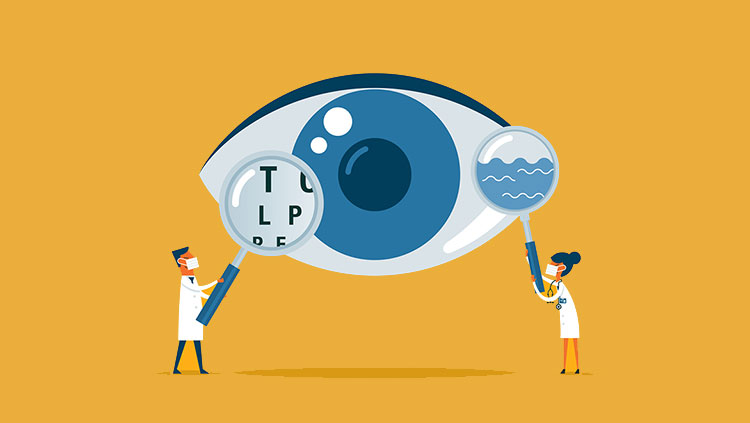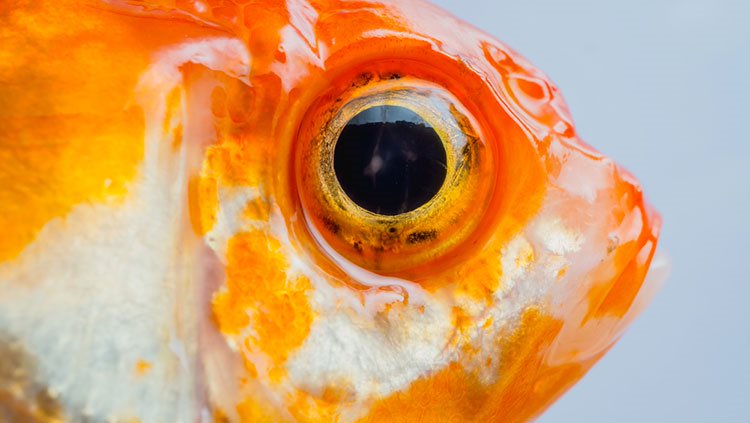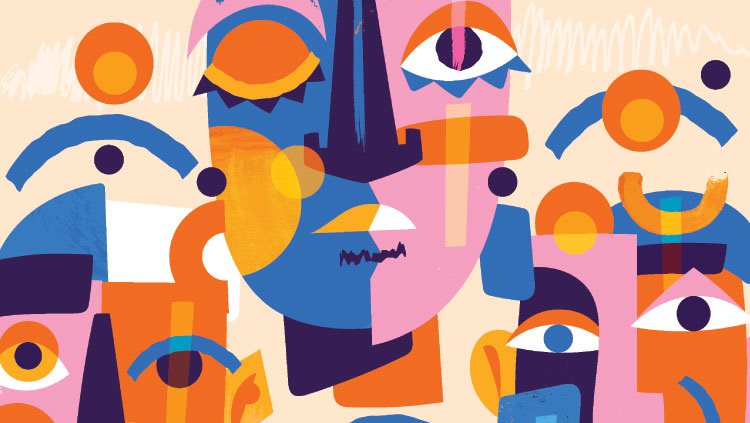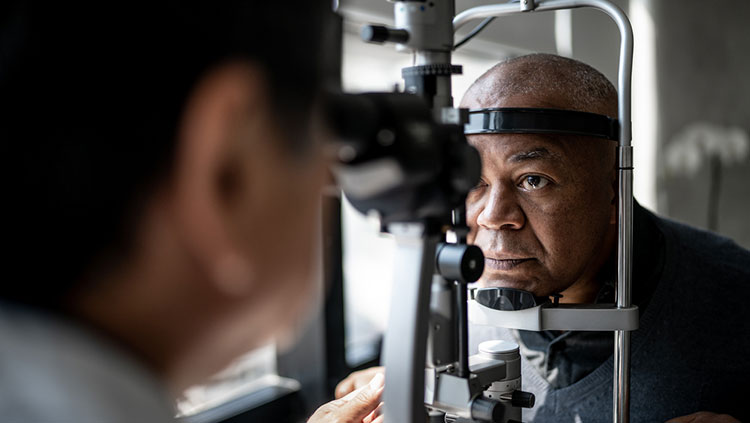Molyneux's Problem: Blind Philosophy
- Published26 Mar 2020
- Author Jessica P. Johnson
- Source BrainFacts/SfN
If you were blind since birth and learned how to identify objects by your sense of touch, could you distinguish those objects by sight alone if your vision was suddenly restored?
This episode of Inner Cosmos was written and produced by Jessica P. Johnson and edited by Lisa Chiu and Juliet M. Beverly.
Music and theme song by Kristina Reznikov.
Hosted by Richard Wingate, Editor-in-Chief of BrainFacts.org and Head of Anatomy at King’s College London.
CONTENT PROVIDED BY
BrainFacts/SfN
Transcript
Richard Wingate: “[Imagine] a Man born blind and taught by his touch to distinguish between a Cube and a Sphere. Suppose then the Cube and Sphere [were] placed on a Table, and the Blind Man … made to see. [Could he now], by his [first] sight, before he touch’d them, … distinguish… which is the Globe and which the Cube.”
This puzzle presented by the English philosopher John Locke in the second edition of his 1694 Essay Concerning Human Understanding, strikes at the fundamental way we perceive our world.
Welcome to Inner Cosmos. I’m Richard Wingate. Journey with us as we explore the universe between your ears. In this episode, Jessica Johnson helps us unravel how modern-day researchers answered this centuries-old query known as Molyneux’s Problem. Jessica, where did Molyneux’s Problem come from and how did it come to be included in Locke’s famous essay?
Jessica Johnson: Well, Richard, Locke first received the question in a letter from the Irish scientist and philosopher William Molyneux in 1688. But Locke didn’t reply to Molyneux right away. That would take another five years, a developing friendship between the two, and a second letter from Molyneux. In the meantime, Molyneux forged ahead on his own with theoretical and scientific explorations of vision. His fascination with vision was likely inspired by his wife going blind from an illness shortly after they were married. He published a major work on the optics of lenses, including those in the eye, telescopes, and microscopes.
When Locke finally decided to reveal his friend’s question to the public, the possibility of reversing blindness through surgery was thought impossible. So, most of the big thinkers of 17th century Europe approached Molyneux’s Problem as a thought experiment about an imaginary situation.
Some, like Molyneux and Locke, thought the answer was no, because without the prior experience of comparing visual and tactile sensory inputs simultaneously, a person couldn’t know that the things they visually perceived were the same as the objects they knew by touch. Others thought yes, if people could reason it out: this cube-shaped object that I’m seeing looks like something that might also feel like a cube, right?
It wasn’t until three decades later, long after the deaths of both Molyneux and Locke, that science began providing some early clues in answer to Molyneux’s Problem.
In 1727, a young English boy was given a choice: undergo a rudimentary form of cataract surgery to push aside the cloudy lenses that rendered him blind since birth or continue as he had for the first 13 years of his life, knowing the world only through his other senses. Surgeries to remove cataracts had been attempted for centuries, but with very limited success. Perhaps feeling he had nothing to lose, the boy chose surgery.
After his surgeon, William Cheselden, successfully removed the first cataract, the boy was unable to visually recognize the objects that, as he described it, “touched his eyes.” He couldn’t tell the difference between his cat and his dog unless he touched them. He couldn’t understand how a two-dimensional painting could represent three-dimensional objects. And even after his second cataract surgery, he appeared to lack depth perception and perspective. However, a year later, the boy showed vast improvement in his ability to identify objects by sight alone.
He became one of the first documented people to experience full recovery from blindness. But, for scientists and philosophers, this anecdotal evidence from a single case collected for only a year after surgery was not quite enough to thoroughly answer Molyneux’s Problem.
Does a person need to be taught to translate the sensory inputs we receive through touch and sight? Or is this ability innate? Cheselden’s well-documented case sparked renewed interest among scientists in designing experiments that they hoped would let them systematically study how newly sighted people see and whether their visual cognition can develop after childhood, and finally put an end to the Molyneux debate.
However, there has been little opportunity to carry out these analyses because cases of reversed blindness after infancy occur so rarely — there have been only a few dozen in the time between Cheselden’s case and the 1950s. In more modern times, cataract surgery is routinely performed on infants born with congenital cataracts in the developed world. And in the developing world, most children go untreated due to lack of funding for these surgeries. Either way, few people who are born blind have their vision restored later in life.
Here’s what we know so far about how the visual system develops:
Richard Wingate: The basic components of our visual systems are laid out by the time we’re born. Our genes direct development of the cornea, lens, and retina — the parts of the eye that collect visual signals from our environment. And the optic nerve carries these signals to a part of our brain called the lateral geniculate nucleus, which receives the signals and relays them along neural pathways to different parts of the visual cortex where they’re interpreted.
Jessica Johnson: Based on the presence of these innate structures, it’s conceivable that a person who only requires minor repairs to the cornea or lens could see normally immediately after corrective surgery. However, it’s also clear that babies born with fully intact visual systems don’t see as well as adults the first moment they open their eyes. This suggests that they must learn to use the tools of their visual system, but also that the system might continue to develop during infancy.
Many scientists believe that this early period of development is not only critical, but also finite. Because as we age, our brains become less plastic — they’re less able to change and form new neural connections. One popular theory is that the visual system stops developing by the time we’re around eight years old. If this is true and a person born blind misses out on this early period of development, it would be impossible for them to achieve normal vision after their blindness is reversed.
Until recently, neuroscientists and physicians continued to rely on the limited information they could gather from just a few old accounts of successfully restored vision to tease out the roles of learning and development in our visual systems and to answer Molyneux’s Problem.
In one of these, the late neuroscientist Oliver Sacks described the experience of a patient he called “Virgil” who saw for the first time at age 50 after cataract surgery in 1991.
Sacks wrote: “Virgil told me … that in this first moment he had no idea what he was seeing. There was light, there was movement, there was color, all mixed up, all meaningless, a blur. Then out of the blur came a voice that said, ‘Well?’
Then, and only then, he said, did he finally realize that this chaos of light and shadow was a face - and, indeed, the face of his surgeon.”
To Virgil and the very few others whose experiences were documented over the years, the visual world was confusing.
Shadows looked like solid objects and every object presented a brand-new visual puzzle to decipher when viewed from the slightest different angle. Virgil bought toy versions of objects so he could practice matching the shapes he felt to what he saw visually. Facial expressions were nearly impossible to read. The process of learning to interpret vision was exhausting and, in some, led to severe depression.
Then in 2009, a neuroscientist named Richard Held had an idea and he brought it to Pawan Sinha, the founder of Project Prakash, a nonprofit that provides free cataract surgeries and corneal grafts to correct blindness in children in India.
This is Pawan Sinha, also professor of vision and computational neuroscience in the Department of Brain and Cognitive Sciences at MIT:
Pawan Sinha: Dick and I went to India together along with a few graduate students and we decided to collect data on the Molyneux Problem with the aid of the Prakash children.
Jessica Johnson: Now they had a pool of people who could help them study whether a blind person can see immediately after their vision is restored and how vision develops after surgery. I asked Pawan what he had expected to find.
Pawan Sinha: I actually remember taking a poll amongst my lab members before we had any data on the Molyneux Problem. Would we find an immediate translation from touch to vision or would there be a period of learning that would be required for this association to be made? And I was pleasantly surprised to find that the students were split about half and half.
Jessica Johnson: In an effort to address the limitations of the few historical case studies that were available, the MIT team carefully chose five children whose circumstances would best answer Molyneux’s question — could a person born blind see normally immediately after their vision was restored? Most of the people in previous cases studies had undergone imperfect surgical procedures, had other health issues that slowed their visual recovery, or had gone blind well after childhood and therefore had prior visual experience. In addition, they were sometimes not evaluated until well after the bandages were removed, missing the first critical days of acclimation to new sight.
The five Prakash children, ages 13-17, began testing immediately. When asked to match identical objects by either touch or sight alone, they matched them almost 100% of the time. But when they had to match objects they could only feel with those they could only see, their success was barely better than chance. This demonstrated that while they clearly had good vision, there was a gap in their ability to make a connection between what they saw with what they felt.
The results of the 2011 study appeared to definitively support Molyneux’s suspicion that a blind person whose vision is restored cannot immediately recognize objects through vision alone. It’s almost as if the touch and vision centers of the brain require a translation step before a person can understand that the different sensory inputs describe the same object. But according to the study, even an older brain can learn this translation step quite quickly.
Here’s how it works: Even as adults, our brains retain the ability to reshape themselves. Individual neurons are constantly pruned and replaced by new ones. This allows our brains to not only recover from injury, but also adapt our behavior to new environments. Our brains are most plastic when we’re young and gradually lose the ability to develop new brain functions as we age. For example, in children born deaf, the brain regions that would normally process auditory information don’t receive any stimulation. So, they become devoted to processing other functions. And it becomes very difficult to reclaim that territory later in life.
The question of how the part of the visual system located deep inside the brain develops from infancy and how plastic it remains into adulthood remains largely a mystery. But the Prakash children demonstrated that even at the ripe old ages of 13-17, at least some plasticity still exists.
Pawan Sinha: Even in the short duration of that study we were finding that these children are able to learn to associate vision and touch in a matter of as short as a week. So right after surgery, they’re unable to do so. But given a week’s worth of experience, they are able to learn that association.
Jessica Johnson: This would suggest that the connection between touch and vision is learned, not innate. However, Sinha says that the brain mechanisms underlying sensory processing are better described as a hybrid of innate and learned features.
Pawan Sinha: So, some amount of structure in the visual pathway is laid down by the genomic information that the nervous system is using in order to pattern itself. That kind of patterning of the visual system does not depend upon visual experience. It’s available innately. And then the finer grain connectivity will be modified by the actual visual experience. So, what would be happening with children who are gaining sight late in life is that they are starting with the visual cortex that’s ready to be changed in response to the visual information they begin to receive.
Jessica Johnson: I asked Pawan which part of the brain is responsible for making these associations between vision and touch, two so-called sensory modalities, which are located in different sensory cortices of the brain.
Pawan Sinha: We don’t really have a good answer yet. You can consider the two ends of a continuum. The one end is that these associations are being made right in the sensory cortices. An alternative possibility is that the two sensory cortices — somatosensation and vision — they are pretty much unimodal and then at some higher stage in the brain’s processing, these two sensations are brought together in what we think of as an association cortex — so, the frontal cortex, which we know receives information from multiple sensory streams. So perhaps [it’s] at that higher stage [that] this association is being made. And just to complicate the picture even further, these two possibilities are not mutually exclusive. It’s quite possible that some of the association is happening right at the level of the sensory cortices, some is happening at the association cortex, and both of these processes are co-progressing.
Jessica Johnson: I also wondered whether the brain of a person deprived of all visual cues except vague light and shadows could ever develop a visual system as well-functioning as that of a person born sighted. People with congenital cataracts see the world as if each eye is covered by a ping pong ball cut in half. Everything is milky white. They can detect changes in the direction and intensity of light, but no detail.
Pawan Sinha: We don’t really know which aspects of vision are acquirable at what ages. All of the Prakash children, without exception, have sub-par acuity. Instead of 20/20 vision, their acuity might be 20 over 60, 20 over 100, sometimes even worse. What we do not know at the moment is exactly why they have poor acuity. We know that it’s not an optical factor. Something about their visual system is not allowing them to see high-resolution details. Another aspect of vision that seems to be permanently compromised is contrast sensitivity — how well can you make out the details when the contrast in the image is reduced. And binocularity or the ability to extract depth from the information from the two eyes. So, in our experience so far, even after both eyes of a child have been treated, the child does not acquire the ability to see depth using stereo vision.
But other aspects of vision, things like being able to use vision to navigate around the environment, to avoid bumping into obstacles, to intercept objects thrown to you, those skills seem to have residual plasticity and you can acquire them even late in life. Another is the ability to tell faces from non-faces. Given a few weeks of visual experience these children are able to acquire that distinction.
Jessica Johnson: Molyneux’s Problem may have finally been answered, but Pawan certainly isn’t done asking questions.
Pawan Sinha: One of the goals of our work is to try to at the very least make some kind of a taxonomy of visual capabilities that are more or less vulnerable to early deprivation and then to try to figure out whether there is some reason why some aspects of vision are more affected by early deprivation and others are not.
Jessica Johnson: He’s also excited about the next steps at Project Prakash.
Pawan Sinha: We have access to a neuro-imaging facility in New Delhi. So, it would be an amazing thing to be able to see that when the brain organization changes in such-and-such a way, this is coincident in time with visual proficiencies. The ability to make that structure and function linkage is very attractive.
Jessica Johnson: Molyneux’s dogged pursuit of the fundamental nature of human vision sparked intense dialogue and research for centuries — he would likely be proud that his fascination with vision proved contagious — and that experimental evidence now appears to support his view.
Our different senses provide us with discrete snapshots of the world. Each one gives us completely different information about an object, with details that can’t be interpreted by the other senses until we learn through experience to integrate them.
Richard Wingate: You’ve been listening to Inner Cosmos. Brought to you by BrainFacts.org, a public information initiative of The Kavli Foundation, the Gatsby Charitable Foundation, and the Society for Neuroscience – global nonprofit organizations dedicated to advancing brain research.
This episode of Inner Cosmos was written and produced by Jessica P. Johnson and edited by Lisa Chiu and Juliet M. Beverly.
Music and theme song by Kristina Reznikov.
And I’m your host, Richard Wingate, Editor-in-Chief of BrainFacts.org and Head of Anatomy at King’s College London.
Visit BrainFacts.org to learn more about your brain and yourself.
References
Bakalar, N. (2011, April 25). Study of Vision Tackles a Philosophy Riddle. The New York Times. Retrieved from https://www.nytimes.com/2011/04/26/health/research/26blind.html
Cheselden, W. (1728). VII. An account of some observations made by a young gentleman, who was born blind, or lost his sight so early, that he had no remembrance of ever having seen, and was couch’d between 13 and 14 Years of age. Philosophical Transactions of the Royal Society of London, 35(402), 447–450. doi: 10.1098/rstl.1727.0038
Degenaar, M., & Lokhorst, G.-J. (2017). Molyneux’s Problem. In E. N. Zalta (Ed.), The Stanford Encyclopedia of Philosophy (Winter 2017). Retrieved from https://plato.stanford.edu/archives/win2017/entries/molyneux-problem/
Gregory, R. L., & Wallace, J. G. (1963). Recovery from early blindness; a case study,. [Cambridge]: [Heffer]. /z-wcorg/. http://www.richardgregory.org/papers/recovery_blind/recovery-from-early-blindness.pdf
Goss, D. (2008). William Molyneux and the optometry content of his 1692 book Dioptrica Nova. Hindsight (Saint Louis, Mo.), 39, 67–71. https://www.ncbi.nlm.nih.gov/pubmed/18831234
Held, R., Ostrovsky, Y., de Gelder, B., Gandhi, T., Ganesh, S., Mathur, U., & Sinha, P. (2011). The newly sighted fail to match seen with felt. Nature Neuroscience, 14(5), 551–553. doi: 10.1038/nn.2795
Johnson, J. P. (2015). Constructing Sound: Auditory Brainstem Implants. BrainFacts.org. Retrieved from https://www.brainfacts.org/diseases-and-disorders/therapies/2015/constructing-sound-auditory-brainstem-implants
Locke, J. (1788). An essay concerning human understanding In four books. Written by John Locke, Gent. Retrieved from http://find.galegroup.com/ecco/infomark.do?contentSet=ECCOArticles&docType=ECCOArticles&bookId=0895300101&type=getFullCitation&tabID=T001&prodId=ECCO&docLevel=TEXT_GRAPHICS&version=1.0&source=library
Molyneux, W., 1688, Letter to John Locke, 7 July, in The Correspondence of John Locke (9 vols.), E.S. de Beer (ed.), Oxford: Clarendon Press, 1978, vol. 3, no. 1064.
Sacks, O. (May 3, 1993). TO SEE AND NOT SEE. The New Yorker. Retrieved from https://www.newyorker.com/magazine/1993/05/10/to-see-and-not-see


